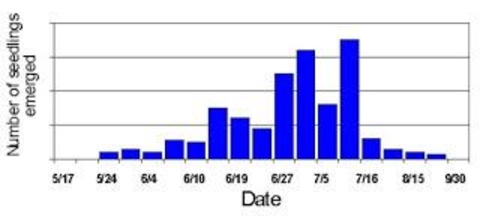Got waterhemp? Layer residual herbicides to maintain control
Waterhemp is increasingly difficult to manage, as it’s becoming more widespread and herbicide-resistant populations are expanding, including multiple-resistant populations.
In addition, it has a long emergence pattern and frequently outlasts control of an early preemergence herbicide application.
One strategy is to layer residual herbicides which helps control glyphosate-resistant waterhemp by extending the duration of seedling control. In fact, research has shown this strategy can provide season-long control for Minnesota soybean.
Research: Layering herbicides for waterhemp control in soybean
In 2015, researchers evaluated the approach of layering residual herbicides in a Rochester trial. The trial included a number of residual herbicides in single and two-pass applications:
- Dual II Magnum (S-metolachlor).
- Outlook (dimethenamid-P).
- Warrant (acetochlor).
Herbicides were selected for their known effectiveness in controlling waterhemp and their flexibility in application timing.
Pursuit (imazethapyr) doesn’t control this population of waterhemp because it’s resistant to Acetolactate Synthase (ALS) herbicides. However, it was applied in tank mixes with the preemergence (PRE) herbicides to eliminate the other non-target broadleaf weeds.
In this trial, researchers applied herbicides on May 5 and June 8, 2015.
A single residual herbicide application early in the season can lose effectiveness before waterhemp emergence hits its peak in late June to early July (Figure 1).
A second or layered application about 30 days after planting will extend the duration of seedling control to cover waterhemp’s extended emergence period.
Study findings
In July, weed control evaluations clearly showed an advantage of the two-pass system over single applications of residual herbicides (Figure 2). Figure 2 below shows a comparison of weed control in soybean with a single preemergence application of Outlook (left) and layered applications of Outlook on May 5 and June 8 (right). Photos taken July 14.
Extended control
The season-long control of the layered or preemergence application followed by a postemergence application (PRE/POST) persisted through the end of the season, while control in the PRE-only treatments continued to diminish (Table 1). By the end of September, waterhemp control was 90 to 95 percent in the two-pass system, compared to 62 to 81 percent in the single PRE application system.
Increased yield
Yields reflected the weed control results with a 10 bushel average difference between the layered and single PRE applications. The yield range of the layered herbicide treatments was 46 to 51 bushels per acre, while the PRE-only treatments ranged from 32 to 43 bushels per acre.
While waterhemp is a challenging weed to manage, this trial demonstrates that layering effective residual herbicides is a strategy that could provide season-long control in Minnesota.
Table 1 shows yields after a residual herbicide was applied either PRE only (after planting, on May 5, 2015) or layered PRE/POST (May 15 and June 8, 2015) in Rochester in 2015. Notes:
-
All PRE treatments included 4 fluid ounces of Pursuit per acre.
-
Waterhemp density on June 8 was 51 per square feet in Pursuit check.
-
The Pursuit weedy check yield was 14 bushels per acre.
Table 1: Common waterhemp control and soybean yield with residual herbicides
| Herbicide | Rate | Application time | 5/27/15 | 6/10/15 | 6/26/15 | 7/8/15 | 9/29/15 | Yield |
|---|---|---|---|---|---|---|---|---|
| Dual II Magnum | 1.5 pints per acre | PRE | 99% control | 96% control | 91% control | 85% control | 81% control | 43 bushels per acre |
| Dual II Magnum | 1.5 pints / 1.0 pints per acre | PRE / POST | 99% control | 98% control | 96% control | 97% control | 95% control | 49 bushels per acre |
| Outlook | 18 fluid ounces per acre | PRE | 99% control | 96% control | 85% control | 73% control | 71% control | 40 bushels per acre |
| Outlook | 14 fluid ounces / 10 fluid ounces per acre | PRE / POST | 99% control | 98% control | 97% control | 97% control | 94% control | 51 bushels per acre |
| Warrant | 1.6 quarts per acre | PRE | 99% control | 91% control | 82% control | 69% control | 62% control | 32 bushels per acre |
| Warrant | 1.6 quarts / 1.6 quarts per acre | PRE / POST | 98% control | 95% control | 95% control | 94% control | 90% control | 46 bushels per acre |
| Least significant difference (LSD) p=0.10 | -- | -- | 1% control | 1% control | 5% control | 7% control | 7% control | 4 bushels per acre |
Reviewed in 2021




